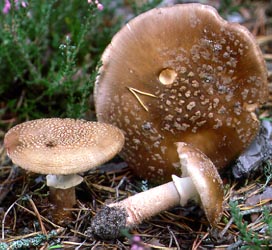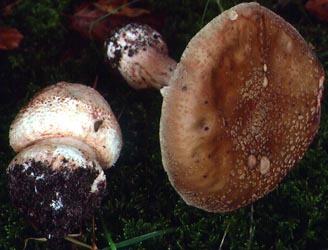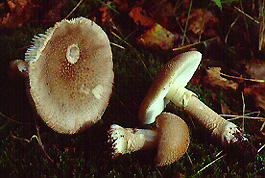|
[ Amanita rubescens f. annulosulfurea (Gillet) Lange ] Amanita
rubescens Pers.:Fr.
Go to technical description. (t.b.d.) BRIEF DESCRIPTION: The cap of Amanita rubescens is 61 - 107 mm wide, brown with the appearance of having radially embedded fibrils, hemispheric at first, then convex to plano-convex to planar, tacky, satiny to shiny, with a nonstriate and nonappendiculate margin. The volva is present as pale brownish gray, small irregular warts, minutely warty, and easily removable. The flesh is 10 - 11.5 mm thick over the stem, thinning evenly towards the margin, white, sordid under the cap skin, pinkish on exposure. The gills are adnate to narrowly adnate, white, 5 - 15 mm broad, with a decurrent line on the stem. The short gills are subattenuate. The stem is 47 - 68 × 17 - 22 mm, white at first, soon bruising or staining pinkish, narrowing upward, flaring slightly at the top, with fibrils and recurved scales. The bulb is 16 - 30 × 26 mm and narrowly turnip-shaped. The ring is placed high on the stem, skirt-like, white at first, becoming cream, collapsing and tearing, with a thickened edge. The volva is present as occasional gray powder above the bulb and is often left entirely in the soil as grayish patches. The flesh is white, staining red brown, and solid. The odor is sweetly fungoid. The spores measure (7.0-) 8.0 - 10.6 (-12.5) × (5.2-) 5.5 - 7.0 (-8.0) µm and are ellipsoid to elongate (rarely broadly ellipsoid) and amyloid. Clamps are not observed at bases of basidia. [Note: RET's spore measurements are based on material from Austria, the Netherlands, Norway, Scotland, Switzerland as well as material introduced to Chile.] Neville and Poumarat (2004) provide the following spore measurements for this species: (7.0-) 7.5 - 10.0 (-11.0) × (5.0-) 5.5 - 7.0 (-8.0) µm. This species was originally described from northern Europe with oak (Quercus) and beech (Fagus). Neville and Poumarat (2004) mention the following associated trees: fir (Abies alba), pine (Pinus pinaster and P. silvestris), oak (Quercus ilex, Q. pubescens, and Q. suber), and chestnut (Castanea sativa). To date, it has not been found in the Americas where there are a number of rubescent species. Although not as frequently as A. muscaria (L.:Fr.) Pers. var. muscaria and A. phalloides (Fr.:Fr.) Link, A. rubescens has been exported to other continents with European trees (for example, Chile in Monterrey pine plantations (Pinus radiata)). For comparison to other rubescent taxa, see A. brunneolocularis Tulloss, Ovrebo & Halling; A. orsonii A. Kumar & T. N. Lakh.; A. novinupta Tulloss & J. Lindgr., A. rubescens var. alba Coker; and A. rubescens var. congolensis Beeli. For distinguishing between rubescent taxa in section Validae, refer to the Key of rubescent taxa in Amanita section Validae. -- R. E. Tulloss and L. Possiel Photos (top to bottom): R. E. Tulloss (northeastern Scotland, with pine; the Netherlands, with beech). "Amanita rubescens f. annulosulfurea" (Gillet) Lange
The name Amanita rubescens f. annulosulfurea is applied to those specimens of Amanita rubescens which differ only in having a sulfur-yellow ring on the stem. Note that this ring is yellow on both top and bottom. The occasional specimen of A. rubescens var. alba (above) or the eastern North American entity locally called "A. rubescens" may have yellow volval material on the bottom of the ring. But these never have an entirely yellow ring in my experience. Dr. C. Bas (Leiden) and I have discussed "f. annulosulfurea," and Dr. Bas informs me that he has searched diligently for other macroscopic or microscopic characters correlated with a colored annulus in European material and that he has found none. This being the case, the name seems unlikely to have any taxonomic value. -- R. E. Tulloss Photo: R. E. Tulloss (northeastern Scotland) Return to Section Validae page. Last changed 8 Mary 2007. |


